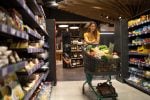Grocery store owners face a hard truth: the typical profit margin in this industry sits at just 1-3%. That’s not a typo. For every $100 in sales, you might keep only $1-3 in actual profit.
In 2025, with rising costs, including food costs, labor expenses, and customer expectations, those thin grocery store profit margins are under constant pressure. Many store owners work 60+ hour weeks just to stay afloat, not to build wealth.
But here’s what most industry consultants won’t tell you: those low average margins hide the real story about grocery stores. While struggling stores barely break even, top performers quietly enjoy higher grocery store profit margins of 8-12%—four times the industry average.
The difference isn’t luck or location. It’s about specific systems and operations strategies that separate profit leaders from the rest.
What if your store could capture even half the grocery store profit margin improvement of top performers? On $2 million in annual sales, that’s an extra $50,000-$100,000 in your pocket each year.
In this guide, I’ll walk through the exact steps high-performing stores take to maximize profits without alienating customers. These aren’t theoretical concepts—they’re practical strategies to help you save money that you can implement starting tomorrow.
The difference between surviving and thriving isn’t about working harder. It’s about working smarter with the right profit-maximizing system in your grocery store.
Boost customer satisfaction with just a few clicks
Most-Loved Features:
- On-demand drivers
- Real-time GPS tracking
- Delivery confirmation photos
- Over 50% of customers report a smoother delivery experience
Step-by-Step Guide to Increase Grocery Store Profit Margins
Streamline inventory with barcoding.
Set competitive prices based on demand.
Build customer loyalty through service.
Step 1: Maximizing Inventory Management Efficiency
It is better to start by implementing efficient inventory tracking methods. You can use inventory software to get real-time updates, which can help reduce waste and make sure you have the right stock levels. Barcoding and RFID technology lets you track each product from arrival to sale. This reduces error and improves stock accuracy.
Conduct regular cycle counts. This means checking a small section of your inventory every few days rather than once a month. Cycle counts help you catch errors sooner. Stock-takes are full inventory counts, ideally done once or twice a year. Together, these practices cut holding costs since you order only what you need.
Utilizing Technology for Inventory Turnover
Barcodes and RFID tags can reduce manual labor and speed up processes. Barcoding involves using a series of numbers and bars that machines can read. RFID uses radio waves to read tags attached to items. These grocery store technologies simplify stock management. This cuts down on waste and ensures you never run out of in-demand items.
Step 2: Effective Pricing Strategies for Grocery Industry
Pricing is crucial for maximizing profits in your grocery store. Analyze your competitors’ prices regularly. If they offer discounts or lower prices , consider matching them or offering something different like bundle deals. Bundle deals mean buying several items together at a reduced price. You can use discount cycles to move products quickly during slower periods.
Adjust prices based on customer demand and stock levels. Assess which products sell faster and adjust their prices to maximize profit. Slow-moving items may benefit from price reductions to clear inventory space. TRUNO highlights that “strategic pricing, such as split/limit pricing,” can boost profits. Consider using pricing software to keep track of price adjustments efficiently.
Strategies for Competitive Pricing and Operating Expenses
Create pricing tiers for different product categories. Pricing tiers help customers see value in higher-tier products and can drive them to make purchases. For instance, store brands and premium organic products can be priced higher than standard items, which offers both variety and perceived quality benefits.
Step 3: Enhancing Customer Experience in Grocery Retail
Focus on customer experience as it can define your brand. Optimize your grocery store to make it easy for shoppers to find what they need quickly. Consider simplifying the navigation by arranging products logically. For example, group all dairy items together. Training grocery store staff to be helpful and efficient can significantly enhance the shopping experience. Regularly schedule staff training sessions focused on customer service skills.
Lighting and cleanliness also play significant roles in customer perception. Well-lit areas make it easier for customers to find products. Cleanliness instills trust. Regular cleaning schedules ensure that your store remains inviting.
Staff Training and Layout Optimization
Set up training for employees to improve how they engage with customers. Tactics include active listening and offering helpful suggestions without being pushy. An optimized layout reduces customer stress and leads to better sales. Conduct periodic surveys to see if your layout changes have been effective.
Step 4: Leveraging Data Analytics for Grocery Sales
Data analytics is a powerful tool. Begin by using your POS (Point of Sale) system to collect sales data and leverage data analytics . This provides information on which items sell best and when. Capture customer preferences and buying habits using customer loyalty programs tied into your POS. Analyze this data to tailor your product offerings.
Interpreting data helps in predicting demand, managing stock levels, and improving sales. You can use historical data to adjust stock orders, ensuring you have popular items available, while less popular items aren’t oversupplied. “With the right approach, you can mine that data for actionable insights,” explains TRUNO.
Using POS Systems for Sales Data Management
POS systems do more than just process sales in grocery stores. They can store valuable data about sales trends and customer behavior. You should make sure your POS system can generate insights on purchasing patterns. These insights can help you adjust inventory, pricing, and marketing strategies to align with customer needs better.
Addressing common queries:
Small grocery stores can be profitable by focusing on niche markets and local products.
The 5 4 3 2 1 rule isn’t about groceries directly but can remind owners to focus on essentials, need-based items, and impulse buys.
Grocery Store Revenue and Net Profit
Running a grocery store with high profits isn’t magic—it’s methodical. By improving inventory tracking, setting smart prices, creating better shopping experiences, and using sales data, you’ve got the tools to boost your profitability and bottom line. These strategies work together: efficient inventory reduces waste, smart pricing attracts customers, and data analysis helps you make better decisions.
Remember that forming partnerships with local suppliers creates unique offerings while steering clear of overstocking keeps your business nimble. When supplier problems arise, having backup plans prevents lost sales and disappointed customers.
The grocery business has thin profit margins, making every percentage point critical. Each strategy you implement strengthens your position against competitors and builds financial stability. Whether you run a small neighborhood market or are an independent grocers larger chain, these approaches work across different store sizes and customer bases.
Your next move? You should pick one strategy from this guide and implement it this week. Track your results, learn from them, and gradually add more strategies. Consistent improvement, even in small steps, leads to significant profit growth over time. Your more profitable grocery business starts today.













